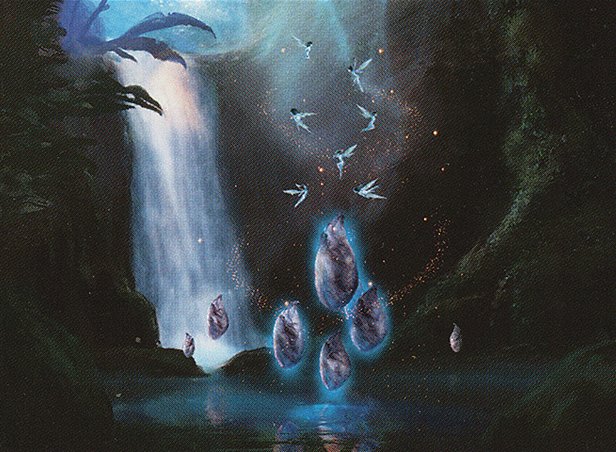 Art by Stephan Martiniere
Art by Stephan MartiniereThis is a 480-card cube for Commander gameplay, that utilizes Commander Legends draft rules to build decks of up to three colors. It utilizes custom or otherwise edited cards to provide a more streamlined experience and adds new custom mechanics for both draft and deck building.
DraftingDrafting for this cube follows similar rules to those of Commander Legends. If you've drafted the format before, it won't be wildly different, but just in case, I'll take the time to explain every step making sure to highlight any way in which the process differs from normal play.
- Each player is given three randomized packs of 20 cards each.
- You open the first pack, pick two cards, and then pass the pack to the player on your left.
- You'll receive a pack from the player to your right, and repeat this process until you run out of cards.
- For the second and third packs, players will be switching the direction in which they're passing their packs. So, first pack to left, second to the right, and third to the left once again.
- Once you're finished, you should have a pool of 60 cards from which you'll build a 60-card deck (including lands) following Commander rules.
Oh, boy. Commander is this format in which you select a legendary creature to serve as your commander. This creature sits outside of the game and can be played as if it were in your hand at all times. If it were to be destroyed, exiled, shuffled into your library, or pretty much leave the battlefield in any way, you can choose to send it back to this special zone. Whenever you cast it from this zone, even if it were to be countered, it costs  additional mana to cast it again from there. So, you pay
additional mana to cast it again from there. So, you pay  extra the first time, then
extra the first time, then  , then
, then  , then
, then  , and so on.
, and so on.
The interesting bit is that your commander's color identity determines which cards you can put into your deck. Let's say you chose a  legendary creature as your commander... idk, Borborygmos Enraged, well, then your deck can't have any cards containing a colored symbol outside of those colors present in your commander. So, no
legendary creature as your commander... idk, Borborygmos Enraged, well, then your deck can't have any cards containing a colored symbol outside of those colors present in your commander. So, no  ,
,  , or
, or  . That includes abilities, so Samut, Voice of Dissent couldn't be part of your deck because of its
. That includes abilities, so Samut, Voice of Dissent couldn't be part of your deck because of its  activated ability, which makes its color identity
activated ability, which makes its color identity 

 .
.
| What about transform cards? |
|---|
A card's color identity takes into consideration both sides of the card, so for transforming cards such as Archangel Avacyn, you should look at both sides when determining her colors. The other side of Avacyn, the Purifier doesn't have any mana symbols on its rule's text nor does it have a mana cost, so, which color is it? Well, some cards have a little colored circle next to the card's type, which determines its color identity. So, if you take both sides, you get a   color identity. color identity. |
During your draft you picked up a few legendary creatures to serve as your commanders, well, now it's time to choose which one/s will helm your deck.
| But, what if... I didn't? |
|---|
| Well, you dun goofed. But, not to worry, just like basic lands are provided for you, you can ask for up to two The Prismatic Piper to supplement your commander needs. These terrible terrible cards will allow you to choose a single color to supplement the color identity of a Legendary Creature with Partner. |
Once you do, separate the cards you won't be using due to falling outside of your commander's color identity. So, if you're playing  , just get rid of your
, just get rid of your  ,
,  , and
, and  cards.
cards.
Pick the cards you absolutely want in your deck, add 25 to 27 lands, and then fill out the rest of your deck with the best of your remaining cards.
Supported archetypesThe environment was designed with a top-down approach, taking the mana shards and wedges and giving each of them a broad but distinct gameplay experience, then finding mechanics that support these experiences for the two-color pairings, and finally, adding mono-colored cards that support as many of these archetypes as possible.
Three-color parings-
War of attrition (


 ): Have you ever had a game that seems to last forever? Well, now you can annoy your friends endlessly with this defense-focused strategy that looks to develop modest but resilient boards and taxing effects, trying to stall the battle while amassing game-ending value engines.
): Have you ever had a game that seems to last forever? Well, now you can annoy your friends endlessly with this defense-focused strategy that looks to develop modest but resilient boards and taxing effects, trying to stall the battle while amassing game-ending value engines. -
Fireworks and fire-works (


 ): Dump your hand just to get a new one with this spellslinging-oriented strategy that focuses on changing various amounts of spells for added value. Cast a spell? Get a card! Oh, and a token... and +1/+1 counter... aaaand another card... you know what, let's go to game two.
): Dump your hand just to get a new one with this spellslinging-oriented strategy that focuses on changing various amounts of spells for added value. Cast a spell? Get a card! Oh, and a token... and +1/+1 counter... aaaand another card... you know what, let's go to game two. -
All out brawl (


 ): Attacking is the name of the game... or was it Magic? It matters little to this strategy as everything to its disposal is nothing more than aggro, aggro, and aggro. As long as you're attacking, you're doing it right. Fast creatures, burn spells, swift removal, and combat tricks are but a few of the tools this strategy offers.
): Attacking is the name of the game... or was it Magic? It matters little to this strategy as everything to its disposal is nothing more than aggro, aggro, and aggro. As long as you're attacking, you're doing it right. Fast creatures, burn spells, swift removal, and combat tricks are but a few of the tools this strategy offers. -
Graveyard shenanigans (


 ): What if your graveyard... was your hand? This strategy looks to fill the graveyard with fun little toys to bring back from the dead using very normal and well-accepted magic. Nothing weird going on here. Some cards even bring themselves back!
): What if your graveyard... was your hand? This strategy looks to fill the graveyard with fun little toys to bring back from the dead using very normal and well-accepted magic. Nothing weird going on here. Some cards even bring themselves back! -
Do the evolution (


 ): There's no greater feeling than having a small puny creature and transforming it into a fearsome threat. That's what this strategy is about. Play a small unassuming creature just to have it become a giant monster right away with polymorphs, evolutions, counters, and enchantments.
): There's no greater feeling than having a small puny creature and transforming it into a fearsome threat. That's what this strategy is about. Play a small unassuming creature just to have it become a giant monster right away with polymorphs, evolutions, counters, and enchantments. -
Build-A-Hero (


 ): Heroes aren't born, they're made. Put all your eggs in a single basket and then equip those eggs with a flamethrower! This strategy focuses on quality rather than quantity, playing board-changing creatures and equipping them with the tools to succeed.
): Heroes aren't born, they're made. Put all your eggs in a single basket and then equip those eggs with a flamethrower! This strategy focuses on quality rather than quantity, playing board-changing creatures and equipping them with the tools to succeed.- Added 8 cards to each color.
-
Future sight (


 ): Do you hate when you draw nothing but lands? Do you hate when you draw anything but lands? Maybe you just hate the game! This strategy looks to set up the perfect draw every time, controlling the top of the library to set up powerful miracles and perfect answers, leaving nothing to chance. Especially the game.
): Do you hate when you draw nothing but lands? Do you hate when you draw anything but lands? Maybe you just hate the game! This strategy looks to set up the perfect draw every time, controlling the top of the library to set up powerful miracles and perfect answers, leaving nothing to chance. Especially the game.- Added 8 cards to each color.
-
What are friends for, really? (


 ): Ever felt like your toolbox wasn't big enough? Well, each of your friends has a deck of their own, so why not use those instead? Take your opponents' best cards for yourself while giving them distractions in the form of small creatures to hit each other with.
): Ever felt like your toolbox wasn't big enough? Well, each of your friends has a deck of their own, so why not use those instead? Take your opponents' best cards for yourself while giving them distractions in the form of small creatures to hit each other with.- Added 8 cards to each color.
-
Scary lizards (


 ): You know what's more terrifying than a giant lizard? That's right, crippling debt... oh, and a giant lizard that also happens to fly. Drag on the game and clear the way until you can dish out your gigantic scaly creatures while your opponents watch in terror behind an empty hand.
): You know what's more terrifying than a giant lizard? That's right, crippling debt... oh, and a giant lizard that also happens to fly. Drag on the game and clear the way until you can dish out your gigantic scaly creatures while your opponents watch in terror behind an empty hand.- Added 8 cards to each color.
-
Land Lords (


 ): Why play one land per turn when you can play six? Realize your dream of homeownership with this strategy that plays lands faster than it should be allowed, strengthening your creatures, triggering effects, and, well, giving you access to like 10 mana by turn five.
): Why play one land per turn when you can play six? Realize your dream of homeownership with this strategy that plays lands faster than it should be allowed, strengthening your creatures, triggering effects, and, well, giving you access to like 10 mana by turn five.- Added 8 cards to each color.
 |  |  |  |  |  |  | |
|---|---|---|---|---|---|---|---|
| Total cards (480) | 60 | 60 | 60 | 60 | 60 | 60 | 120 |
| % of creatures | 62% | 50% | 56% | 52% | 58% | 0% | 56% |
| % of non-creatures | 48% | 50% | 44% | 48% | 42% | 100% | 44% |
Three-color Partner: Partner as a mechanic has been limited for this cube experience, making it so any grouping of two commanders can have up to a maximum of three colors between the two of them. This means that, while both Thrasios, Triton Hero and Tymna the Weaver possess the Partner mechanic, they would be an illegal pairing for this environment, as their color identity would be 


 , which exceeds the maximum by one color.
, which exceeds the maximum by one color.
Card Packages (maybe change the name): Some cards in the cube yield extra copies at the end of the draft. This is shown by a white "x" followed by a number, showing the total amount of copies that card represents. Seven Dwarves, for example, has x7, signifying that at the end of the draft, extra copies of that card will be added to your pool until you reach the allotted number. In this case, 7.
New Partners: Some legendary cards in the cube have been given the Partner mechanic to ensure every archetype is appropriately represented.
Modified Cards: Some cards in the cube have been modified to better fit this format. These changes maintain the cards' original mechanical intent but enable new avenues of play. Tetzimoc, Primal Death, for example, has been given Eminence, allowing you to activate its ability from both your hand and the command zone. This makes Tetzimoc a lot stronger, but only if you're willing to play a monoblack deck.
Things to do Design- Define how many commanders should each color have at a minimum.
- Define how many Partner commanders should the cube have.
- Finish deciding the two-color strategies.
- Look for mono-colored cards that help all strategies they're involved in.
- Decide how to handle the "+" Package Cards.
- Add new partners.
- Write about painful fixing.
- Explain how edited cards look
- Choose a better name for Package Cards
- Compile a list of new partners.
- Choose a name for the cube.
- Finish writing the archetypes section.
- Explain the drafting rules so that all the information is in one place.
- Add 8 commanders for every archetype, 2 three-color commanders, 1 for each two-color combination, and one mono-color commander with Partner for each color.
